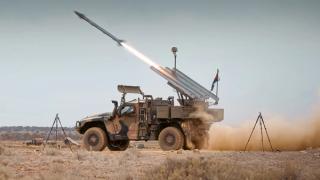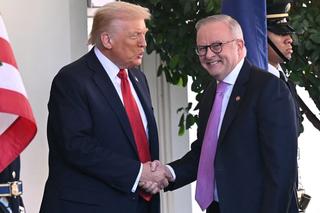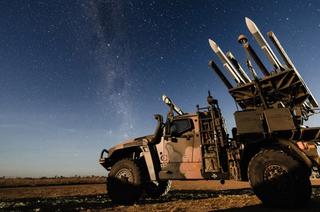Foreword
Esther Soulard
Senior Research Associate, Foreign Policy and Defence, United States Studies Centre
Dr Christopher J. Watterson
Research Fellow, Foreign Policy and Defence, United States Studies Centre
Since Prime Minister Curtis’ 1941 ‘turn to America’, Australians have come to view the Australia-US Alliance as sacrosanct — the bedrock of its national security and a cornerstone of regional stability in the Indo-Pacific region. Born out of a shared struggle during the Second World War, the enduring relationship has been forged in shared values and interests, formalised with the ANZUS Treaty in 1951, and cemented through decades of trust and strategic alignment.
Since, the Australia-US Alliance has commanded longstanding bipartisan support on both sides of the Pacific. For Australia, the Alliance underwrites its defence, lends economic and technological benefits, and bolsters its agency and voice on a regional stage. For the United States, the Alliance means access to a reliable and capable partner’s geography with a shared vision and commitment to regional security. In 2021, the announcement of the AUKUS partnership stood as a symbol of the Alliance’s maturity.
Yet, a mere four years later, the Australia-US relationship is at an inflection point. Under the second Administration of President Donald Trump, Australians’ trust in their ally has dropped, with Lowy Institute polling suggesting just 36% of Australians express significant trust in the United States ‘to act responsibly in the world’. Controversial Administration policies, including tariffs, pressure to increase defence spending and the launch of a review into AUKUS, raised doubts around US leadership and its commitment to the security of its allies, fuelling an increasingly assertive Australian debate on sovereignty, risk and self-reliance.
At such a critical juncture, it is more vital than ever to evaluate both the rationale for the Alliance and its deep historical and structural underpinnings.
At such a critical juncture, it is more vital than ever to evaluate both the rationale for the Alliance and its deep historical and structural underpinnings. Since ANZUS, principal strategic documents from Australia and the United States have consistently reaffirmed the centrality of the Alliance to their respective national interests, and to the Indo-Pacific security architecture. Today, both partners enjoy unprecedented levels of strategic alignment and military interoperability through various cooperative frameworks, such as the Force Posture Agreement (2014), the AUKUS Security Partnership (2021) and the Five Eyes intelligence sharing agreement.
This security and defence cooperation has been coupled with robust economic, cultural and societal ties. The United States was Australia’s second-largest two-way trading partner in 2024 and has remained its largest source of foreign investment for decades. Since the Australia-United States Free Trade Agreement (AUSFTA) came into force in 2005, bilateral trade in goods and services has tripled, and two-way investment has quadrupled. Meanwhile, the plethora of educational and academic exchanges; scientific, cultural, and professional collaborations; as well as diaspora, tourism and other civic connections, have fostered mutual trust as well as sustained the relationship’s resilience over decades.
Amid declining trust in the Alliance, awareness and understanding of these links should not be assumed. Established in 2007, the United States Studies Centre (USSC) seeks to deepen public understanding of the Australia-US relationship and to offer policy options for Australia to shape US engagement in the Indo-Pacific. Its Next Generation Challenges in the Australia-US Alliance, funded by the US State Department, embraces an intergenerational approach to this endeavour.
Over the past 18 months, the USSC hosted six workshops for 67 emerging Australian leaders under 30 years old to discuss opportunities and challenges facing the Alliance with seasoned US and Australian experts. Several of these emerging leaders were invited to author commentaries on what they saw as critical issues and trends shaping the future of the bilateral relationship. This report contains four commentaries authored by our next-generation leaders in the Alliance. These pieces demonstrate the ongoing importance of the Alliance to the next generation of Australian leaders and offer insights into how young Australians are weighing the future of the Alliance.
These commentaries demonstrate the ongoing importance of the Alliance to the next generation of Australian leaders and offer insights into how young Australians are weighing the future of the Alliance.
Linus Cohen and Neve Hawkins begin by arguing that AUKUS Pillar II must evolve to support allied forces that are now critically vulnerable to rapid attrition in a high-intensity conflict, particularly given China’s advanced defence-industrial capacity. Darcey Watson, Sharlet Merin Sunny, and Niyant Shankar then argue that recent US export control reforms represent an opportunity for Australia to build its sovereign space capability in ways that both support the alliance and regional stability. Steve Kuper, Mathieu Bazin, and Philip Citowicki highlight coordination challenges facing allied defence industry integration, calling for the breaking down of bureaucratic silos between government, industry, and the military. Lastly, Jemimah Roberts and Calvin Lu argue that the current debate about the Alliance reflects Australia’s choice for pragmatism amid uncertainty, rather than any waning of the relationship. Crucially, across the board, these pieces capture a generational view of the Alliance as integral for Australia to effectively navigate an increasingly contested Indo-Pacific, best leveraged when Canberra exercises self-reliance and shapes US regional engagement.
In 1953, the Adelaide Advertiser published an op-ed stating that “it would be exaggerating to say that a remote and sparsely populated Australia is having a decisive influence on the headstrong foreign policies of the most powerful country on earth. But the influence is there. It counts for something.” Seventy-four years on — these commentaries offer a window to place young leaders at the forefront of this vision.
This project is generously supported by a grant from the US State Department.

Stemming the tide: Why attrition mitigation is crucial for AUKUS Pillar II
Linus Cohen
Researcher, Australian Strategic Policy Institute
Neve Hawkins
Strategic Communications Consultant, FTI Consulting
Accepted for publication: 4 September 2025
AUKUS Pillar II continues to lay the groundwork for a long-term defence-industrial uplift across the United States and its allies. But it lacks — and needs — a more direct approach to the AUKUS partners’ near-term strategic problems. Chief among those problems is attrition: the rapid loss of warships and aircraft in a high-intensity conflict, and the relative disadvantage of US and allied defence industries to the ‘Axis of Upheaval’ in replacing them. For the remainder of the decade, Pillar II should focus its efforts on making those assets harder to neutralise.
Pillar II has promised a platform for technology cooperation and a handful of workstreams centred on specific advanced capability areas. Reforming structural and cultural barriers to an allied innovation ecosystem is as necessary as it is underappreciated. But Pillar II has yet to find a strategic logic for the near term that complements Pillar I’s ambition for Australian efforts to acquire a conventionally armed, nuclear-powered submarine capability. Ubiquitous talk about Pillar II’s aims to accelerate capability delivery — in which progress has been so far modest and unintegrated — cannot guide decisions over what capabilities to prioritise. If unattended, bureaucratic inertia and political expediency — instead of strategy — will set those priorities. The United States Studies Centre’s Prof Peter Dean and Alice Nason thus argue that Pillar II needs “one to three marquee programs oriented around shared force structure concerns” to provide the requisite focus.
In the near term, the AUKUS partners’ primary concern should be mitigating the attrition of hard-to-replace military assets.
In a short, sharp war, both sides would lose significant amounts of capability very quickly, but China would be better positioned to reconstitute losses over the subsequent three to five years.
A high-intensity conflict between China and a US-led coalition would almost certainly rapidly destroy major capital assets on both sides. In 2023, wargaming by the Center for Strategic and International Studies, simulating an attempted Chinese invasion of Taiwan, predicted that even in optimistic scenarios with a clear coalition victory, a month of fighting would wipe out US combat aircraft in the low hundreds. Of those located in the Indo-Pacific region, some 90% would be destroyed on bases before they could take off, and almost all large surface combatants in the Western Pacific would sink.
While a considerable portion of the People’s Liberation Army Navy (PLAN) would also be destroyed, coalition losses would produce greater relative disadvantage. The immense capacity of China’s defence industries — notably in shipbuilding, where its capacity outmatches the United States by a factor of over 200 — creates relative advantage for China in the period after a highly attritional first few weeks of combat. In a short, sharp war, both sides would lose significant amounts of capability very quickly, but China would be better positioned to reconstitute losses over the subsequent three to five years.
That matters, because the calculation behind initiating a war of this kind won’t solely concern the balance of forces that exists on day one, but also that which plausibly would exist a month after the conflict starts — or a year, or several. Even an overmatch sufficient to practically ensure a rapid Chinese defeat in an attempted invasion of Taiwan will be inadequate to deter — if it leaves open the possibility for China to absorb a stinging mutual loss in the near term, using its industrial might to create an advantageous regional balance for subsequent stages of competition.
The United States and its partners can and must uplift their defence industries for long-term competition. But decades of underinvestment will not be wound back overnight; genuine structural reform will take sustained effort over multiple terms of government. To mitigate their relative disadvantage in the near term, the AUKUS partners must drive down the amount of capability that could be lost in the first place.
The goal is not just to develop new capabilities, but to field them in ways that meaningfully reduce vulnerability in the opening stages of conflict.
Defeating or degrading links in an adversary’s kill chain — increasing the cost and complexity of an anti-access and area denial (A2/AD) strategy designed to overwhelm allied forces — must become the key criterion guiding near-term Pillar II investment. Allied munitions production for air and missile defence, while important, is only one part of that equation. Enhancing the probability of kill for each munition and — reducing the number required to defend — is another. That requires better targeting, sensor integration and decision support. Pillar II investments in hypersonic weapons, if only for the near term, should prioritise defence over offence — detection and tracking over novel munitions that are unlikely to be economical to field in relevant quantities in the next five years. Equally important is degrading the adversary’s ability to target allied forces in the first place. Pillar II’s existing workstreams on electronic warfare, cyber and autonomous systems should prioritise capabilities that obscure, deceive or overload an adversary’s battlefield awareness.
Pillar II must now move with urgency. The goal is not just to develop new capabilities, but to field them in ways that meaningfully reduce vulnerability in the opening stages of conflict. That is the standard by which the next few years of investment should be judged.

Opening the launch window: Export control reform and Australia’s strategic opportunity
Darcey Watson
Executive Officer, Andy Thomas Space Foundation
Sharlet Merin Sunny
Project Coordinator, Space Industry Association of Australia
Niyant Shankar
Senior Consultant, Strategy & Operations, KPMG Australia
Accepted: 10 November 2025
Does Australia have an opportunity to become a global space power?
Established in 1987 by the G7 nations,1 the Missile Technology Control Regime (MTCR) is a voluntary multilateral export control regime designed to limit the spread of missiles and unmanned aerial vehicles capable of delivering weapons of mass destruction. The MTCR provides a regulatory framework that informs member nations’ national export control regimes, supporting global non-proliferation efforts.
While the MTCR has long enjoyed top-level political support amongst member states, rising geopolitical tensions and stringent regulations, as seen through strict export controls from the US, have undermined and ultimately hindered defence collaboration amongst allies, while rivals have been able to exploit its rigidity to expand their influence.
The ongoing relaxation of US export controls for MTCR-regulated technologies since 2018 marks a shift away from rigid gatekeeping of these technologies toward the strategic uplift of allies. This policy shift — in particular as it applies to space-based and dual-use systems — stands to bolster the civil and defence space industries of US allies.
Unlocking strategic access for Australia’s space ecosystem
The easing of US export controls under the International Traffic in Arms Regulations (ITAR) and the MTCR offers a pivotal opening for Australian space companies. Previously, onerous ITAR rules discouraged Australian companies from using US components or selling to American customers. However, recent US reforms are expected to “broaden the scope of future space partnerships with US allies and partners,” reducing licensing and knowledge transfer barriers for Australian companies.
Easing restrictions enables Australian companies to gain greater access to global supply chains and partnership opportunities, including in the co-development of military satellites, intelligence, surveillance and reconnaissance (ISR) systems, and command-and-control platforms.
These US reforms also support other agreements, including AUKUS Pillar II, in areas such as hypersonic and counter-hypersonic weapons, and the new Deep Space Advanced Radar Capability set to provide constant tracking of objects in space (with the first site planned for Western Australia by 2026). However, obstacles, including longstanding US export-control provisions, remain before such integration can be fully realised.
Australia, for its part, has also been pursuing enabling regulatory reform, including an amended export control framework within the Defence Trade Controls Amendment Act (DTCA) 2024, which better aligns with US regulations and enables reciprocal licensing exemptions.
Rethinking advantage: How emerging players can compete and lead
The 2024 DTCA established a licence-free export environment for most Defence Strategic Goods List items between Australia, the United States and the United Kingdom, eliminating hundreds of export permits and reducing arduous compliance barriers for industry, research and academia. This unlocked an estimated AUD $5 billion in economic benefit.
Further gains can be realised through compliance agility, readiness to integrate and strategic alignment with shared missions between the AUKUS countries. Recent priorities in the Australian space sector include propulsion and autonomy for satellite and ISR systems, alongside the closer collaboration observed through AUKUS.
The MTCR reforms represent a turning point, balancing non-proliferation with the realities of strategic technology transfer.
This shift in operational focus could uplift Australia’s role in international space development from consumers and downstream integrators to co-creators of foundational intellectual property, especially in domains like in-space manufacturing, responsive launch and propulsion technologies.
Australia should not only adapt to the changing regulatory environment but seize upon it with ambition, institutional infrastructure and a vision to move from participation to leadership.
Enabling the ecosystem: A call to policy, industry and academia
Actionable recommendations for government, industry and academia to harness these reforms include:
- Bolster information security: recalibrating Australia’s MTCR policy settings to responsibly manage the inflow of sensitive technology, while maximising sovereign capability gains.
- Clarify ideation to implementation: investing in clear speed-to-capability pathways and structuring bilateral innovation initiatives.
- Considered consultation: engaging in joint policy discussions to contextualise updated guidelines, particularly in areas critical to Australia’s current and projected programs.
- Increase compliance support: providing tailored briefings, training, and guidance, especially for emerging players and research institutions.
- Collaborate for growth: working with trusted international partners, leveraging MTCR updates to accelerate technology transfer, and building commercial scale.
The MTCR reforms represent a turning point, balancing non-proliferation with the realities of strategic technology transfer.
Ultimately, if implemented with coordination and foresight, reforms can catalyse an era of innovation, cooperation and economic opportunity for the Australian space and defence sectors, delivering tangible benefits to security and long-term prosperity.
For Australia, this is both a test and an opportunity: to responsibly embrace new capabilities, reinforce alliances, and shape the norms and technologies that will define the future of security, space and sovereign advantage — strengthening our position as a reliable and capable power in the global space economy.

Symbiotic deterrence: Ensuring industry and government can help our warfighter ‘fight tonight’… and tomorrow
Steve Kuper
Lead — Defence & Aerospace, Momentum Markets
Mathieu Bazin
BAE Systems Australia
Philip Citowicki
Adjunct Fellow, Adelaide University
Accepted for publication: 24 September 2025
Prolonged conflicts in Europe and the Middle East have demonstrated that any credible deterrence strategy depends on the capacity of a nation and its allies to not only fight tonight, but to sustain that fight for a protracted period. This has implications for Australia, which is managing an intensifying US-China strategic competition in the Indo-Pacific.
Yet, despite the apparent urgency of the moment and Australia’s challenging strategic circumstances, there remains a significant disconnect between industry, government and defence. While the 2023 Defence Strategic Review (DSR) rightly emphasised the need for rapid capability delivery and a more focused posture, it also offered the foundations for deep structural reforms designed to break down independent silos between the three parties. Similar debates are playing out in the United States (US), with successive US administrations recognising persistent capability and capacity shortfalls in the US defence industrial base.
All too often, the defence-industrial relationship is troubled by bureaucratic lethargy and short-term decision-making.
The United States and Australia can get after coordination challenges between industry, government and defence by prioritising reform in three key relationships: government-industry, industry-military and US-Australia. Doing so will reinforce the relationship between Australia and the United States, promote their respective defence industrial bases and build sustainable ‘symbiotic’ deterrence between the two partners.
The first relationship that demands attention is that between government and industry, both in Australia and the United States. All too often, the defence-industrial relationship is troubled by bureaucratic lethargy and short-term decision-making.
Despite governmental efforts to reduce bureaucratic constraints on industry — for example, through recent changes to the International Traffic in Arms Regulations (ITAR) and Missile Technology Control Regime (MTCR) regulations — challenges persist in the form of uncertainty around long-term defence spending, deferred or delayed programs in the short term, and volatile public opinion on defence and alliance matters. A lack of consistency regarding governmental expenditure and priorities could have harmful effects on both industrial bases.
The mobilisation of AUKUS through its industrial partners will be the true litmus test of whether Canberra can move beyond its traditional standardised templates for procurement and contracting, commonly referred to as Australian Standard for Defence Contracting (ASDEFCON) practices, which rely on punitive contractual measures to enforce cost and schedule. Success will require a shift to a more productive model: one that prioritises guidance, assurance and active promotion of industry-identified opportunities to strengthen and sustain growing defence demand.
Enhanced coordination of defence industry programs and research will mitigate costly duplications of effort, allow the cross-pollination of ideas, and facilitate the rapid commercialisation of technology and platforms to solve common mission sets.
The second relationship that demands attention is that between industry and the military. Too often, technology is developed in isolation from its intended battlefield role, tactical requirements and practical constraints. Feedback from end-users must inform design from day one — particularly as new technologies change how modern warfighting is taking place. In this sense, JORN Phase 6, Defence’s project to redesign and upgrade the Jindalee Operational Radar Network, serves as an example of building to purpose, rather than building to specification. Its success in releasing the Operations Centre ahead of contracted dates or in developing a ‘capability delivery model’ to improve efficiency on an ongoing basis demonstrates the power of close industry and end-user collaboration.
The third relationship that demands constant attention is the bilateral US-Australia relationship. Enhanced coordination of defence industry programs and research will mitigate costly duplications of effort, allow the cross-pollination of ideas, and facilitate the rapid commercialisation of technology and platforms to solve common mission sets.
Critically, here lies the opportunity for both Australia and the United States to rebuild their respective industrial bases in a symbiotic and complementary manner. Achieving this will bolster their respective defence industrial bases, building much-needed scale, capacity and redundancy across both nations, thereby establishing Australia as a true partner in US deterrence capability. Anything less risks leaving both allies vulnerable in the critical moment when deterrence must hold firm.

Tone and trust: A nuanced US-Australia alliance
Dr Jemimah Roberts
Lecturer, Macquarie Law School, Macquarie University
Calvin Lu
Senior Consultant, FTI Consulting
Accepted for publication: 13 August 2025
On 5 July 2025, Australian Prime Minister Anthony Albanese delivered the John Curtin Oration, marking 80 years since the death of the former Labor leader and icon. Curtin’s wartime declaration in 1941 that Australia would ‘look to America’ has long been regarded as a turning point in Australia’s foreign policy, and a critical juncture in the US-Australia relationship.
After paying tribute to Curtin’s legacy, Albanese went on to draw parallels between Curtin’s era and today’s current geopolitical environment. “Curtin’s words,” he argued, “were much more than the idea of trading one strategic guarantor for another.” Instead, they reflected “a recognition that Australia’s fate would be decided in our region,” and a call for “[s]peaking for ourselves, as a sovereign nation.” The Prime Minister insisted that “[w]e needed an Australian foreign policy anchored in strategic reality, not bound by tradition.”
The speech ignited a wave of political and media commentary in response. Opposition Leader Sussan Ley contended that “now is a time to build our influence in Washington, not diminish it,” and that “many Australians will wonder whether this speech at this time is in our national interest.” Seasoned foreign affairs journalist, Greg Sheridan went further, criticising it as a “bizarre ‘look away from America’ speech” that dangerously “implies greater Australian strategic distance from the US.”
Despite this rhetoric, Australia’s current alliance posture arguably reflects a shift in tone, rather than substance. But is a more measured, independent approach in the short-term necessarily a bad thing?
Public opinion
Recent polling suggests that Australians are increasingly concerned about the direction of US leadership under President Donald Trump. The 2025 Lowy Institute Poll reports a 20-point drop in public trust in the United States to act responsibly in the world since 2024, reaching a historical low (in the poll’s two-decade history) of only 36% of Australians expressing any level of such trust in the United States. The data reveals deep unease with Trump’s policies: overwhelming majorities disapprove of Trump’s attempt to annex Greenland (89%); his use of tariffs as a tool of coercive statecraft (81%); and his withdrawal from the Paris Agreement on climate change (74%). Trump’s attempts to broker a deal with Vladimir Putin on Ukraine have also drawn widespread disapproval (74%).
Despite this collapse in public trust in the United States, Australian support for the US-Australia alliance remains strong.
Similarly, Pew Research Centre data indicates that 77% of Australians have little to no confidence in Trump in 2025, out of which 58% have no confidence at all in Trump. This accounts for a sharp decline since 2024, with Australian public confidence in the US president’s ability ‘to do the right thing regarding world affairs’ down 18 points from levels recorded during Biden’s presidency.
Despite this collapse in public trust in the United States, Australian support for the US-Australia alliance remains strong. According to the Lowy Institute, in 2025, 80% of Australians still view the alliance as ‘very’ or ‘fairly’ important for Australia’s security; only slightly down from 83% the previous year. This apparent disconnect — disapproval of the Trump presidency, yet enduring support for the alliance — suggests Australians are not rejecting the partnership altogether. This is not strategic distancing in a substantive sense, but rather a recalibration in tone: a more cautious, independent posture shaped by public sentiment and the unpredictability of the current US administration.
Trade perspective
The imposition of a 10% tariff on Australian exports as well as considerable sectoral tariffs by the Trump administration added economic strain to the bilateral relationship. This volatility may also justify a shift towards more independent rhetoric during this period, coupled with a more pragmatic and diversified approach to trade. While such tariffs undoubtedly hurt Australian exporters, they can also serve as a catalyst for identifying alternative markets and diversifying export locations. As the Queensland Chamber of Commerce and Industry outlined, “Market diversification is a critical element of risk management and will help to reduce the economic impact of any political, economic or public health shock emanating from one country.”
In addition to being a prudent short-term response to mitigate the economic shock of recent tariffs, such a shift may also offer long-term strategic benefits. If trade relations improve — such as through the removal of tariffs — it could pave the way for renewed bilateral economic engagement.
Conclusion
Australia’s alliance with the United States remains a cornerstone of its foreign and defence policy. Maintaining close ties with Washington is clearly in Australia’s national interest, grounded in shared democratic values and mutual reliance for security and prosperity. However, recent developments under the Trump administration — and broader shifts in alliance dynamics — have prompted a more measured and independent tone in Australia’s public discourse.
This short-term, rhetorical recalibration should not be mistaken for a weakening of the alliance. Rather, it reflects a pragmatic response to current uncertainty — an attempt to preserve substantive commitments with a critical ally while cautiously navigating the current geopolitical landscape. If both countries move towards a more open and cooperative relationship in the future, stepping beyond this period of cautious engagement could serve as an opportunity for renewal in a way that reflects contemporary realities and long-term interests.





